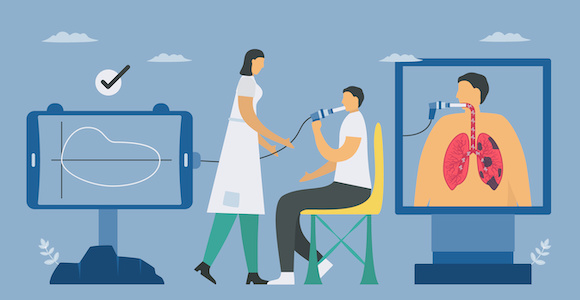- Home
- Departments
Departments Of Pulmonary Function Tests-Spiromerty
Pulmonary- Function Tests-SpiromertyPulmonary function tests (PFTs), specifically spirometry, are diagnostic tests used to evaluate the function and capacity of the lungs. Spirometry measures the volume and flow of air during inhalation and exhalation and provides valuable information about lung function, including lung volumes, airflow rates, and the presence of any respiratory abnormalities.
Key Components of Spirometry:
Lung Volumes: Spirometry measures various lung volumes, including tidal volume (the volume of air inhaled or exhaled during normal breathing), inspiratory reserve volume (the maximum amount of air that can be inhaled after a normal inhalation), expiratory reserve volume (the maximum amount of air that can be exhaled after a normal exhalation), and residual volume (the volume of air remaining in the lungs after a maximal exhalation).
Flow Rates: Spirometry also assesses airflow rates, including forced expiratory volume in one second (FEV1), forced vital capacity (FVC), FEV1/FVC ratio, peak expiratory flow rate (PEF), and maximal mid-expiratory flow rate (FEF25-75%). These measurements provide information about the speed and efficiency of airflow during forced expiration and can help identify airflow limitations or obstruction.
Procedure: During spirometry, the patient is instructed to breathe into a handheld device called a spirometer, which measures the volume and flow of air. The patient takes a deep breath and then exhales forcefully and completely into the spirometer as quickly and as long as possible. The spirometer records the volume and flow of air during both inhalation and exhalation. Multiple maneuvers are typically performed to ensure accurate and reproducible results.
Interpretation: The results of spirometry are interpreted by comparing the patient's measurements to predicted values based on age, sex, height, and ethnicity. Abnormal spirometry findings may indicate various respiratory conditions, including obstructive lung diseases (such as asthma, chronic obstructive pulmonary disease [COPD], or bronchiolitis), restrictive lung diseases (such as pulmonary fibrosis or chest wall abnormalities), or mixed patterns of obstruction and restriction.
Clinical Applications: Spirometry is widely used in clinical practice for diagnosing and monitoring respiratory conditions, assessing the severity of lung disease, evaluating treatment responses, and predicting prognosis. It can help differentiate between obstructive and restrictive lung diseases, assess airway reactivity and bronchial hyperresponsiveness, and guide therapeutic decisions, such as the initiation of bronchodilator therapy or the optimization of inhaler technique.
Limitations: While spirometry is a valuable diagnostic tool, it has some limitations. It may not detect mild or early-stage lung disease, and results can be influenced by factors such as patient effort, technique, and cooperation. Spirometry should be interpreted in conjunction with clinical history, physical examination, other diagnostic tests, and imaging studies to establish a comprehensive diagnosis and management plan.
Overall, spirometry is a fundamental component of pulmonary function testing and plays a critical role in the assessment and management of various respiratory conditions. It provides objective measurements of lung function and helps healthcare providers make informed decisions about patient care, treatment strategies, and prognosis. Close collaboration between clinicians, respiratory therapists, and other healthcare professionals is essential to ensure accurate and meaningful interpretation of spirometry results.

